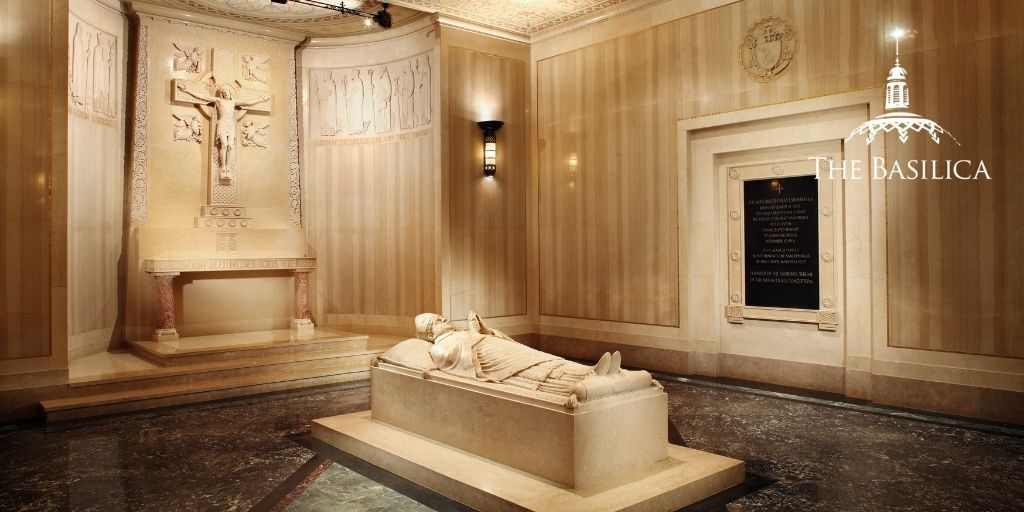
“A glorious church… speaks with a divine eloquence that nothing can equal.” – Bishop Thomas Shahan
The name Thomas Shahan may not be familiar to many American Catholics. Yet without Bishop Thomas Shahan, “America’s Catholic Church” would not exist as we know it today. The visionary behind the National Shrine, Bishop Thomas Shahan guided it from conception to construction. On March 9, the 89th anniversary of his death, we celebrate his life and impact on the founding of the National Shrine.
 Bishop Shahan’s Vision
Bishop Shahan’s Vision
It was Thomas Shahan who first presented a plan for a national church in honor of the Blessed Mother in Washington, D.C to Pope Pius X in 1913. In response, the Holy Father gave his apostolic blessing and a personal contribution.
When Bishop Thomas Shahan first guided the construction of the National Shrine, he sought an aesthetic that would reflect beauty and eternal truth. He strove to create a building that would enhance sacramental life and serve as a “National Monument or testimony” resting “on a national devotion to the Blessed Virgin.”
Some of the earliest concepts for the church were in the style of a Gothic cathedral, but as a scholar and historian, Shahan felt that the contributions of the modern age could not compete with the basilicas of early Christianity and the cathedrals of the middle ages. He envisioned a style combining the symmetry and eloquence of the ancient basilica (Romanesque) with the mystical language of the mosaic and the triumph of the dome (Byzantine).
Architects ultimately settled on this Romanesque-Byzantine fusion in order to create an original design that was “sunk in tradition yet distinctively American.” The Romanesque-Byzantine style was also chosen to be distinct from the Washington National Cathedral, the Gothic Episcopalian cathedral whose construction was underway at the time.
 Honoring Bishop Shahan at the Basilica
Honoring Bishop Shahan at the Basilica
Bishop Shahan was actively involved in the construction of the National Shrine until his death on March 9, 1932. To this day, Bishop Shahan remains the only person to be interred at the Basilica; his body is three feet directly beneath the sarcophagus in the Ave Maria Chapel, which he himself named. The life-size recumbent statue was created by Charles D. Maginnis using his death mask. Seeking to honor Shahan’s memory, Msgr. Patrick O’Connor, sixth director of the National Shrine, gave the space the eponym of the “Founder’s Chapel.” It was not finished until three decades after Shahan’s death in 1962.
The Founder’s Chapel honors Bishop Shahan’s Irish ancestry with portrayals of Irish saints. The crucifix is set with seven mystical roses, symbols for Mary, as well as a circle inset with a square, symbolizing eternity and the temporal world. It is marked with the Greek word nika, meaning “victor” and Greek letters IC-XC, signifying Jesus Christ. Bishop Shahan is also portrayed in a bronze bust in the Hall of American Saints.
A Monument of Artistic Truth
Over a decade before the foundation stone was even placed, Bishop Thomas Shahan had a vision for the National Shrine. In 1910, he wrote of his early plans for the church to Mr. Michael Jenkins of the CUA Board of Trustees:
A glorious Church sheds a warm, emotional, sacramental light, and speaks with a divine eloquence that nothing can equal. I would not presume to dictate the style of it… But I have always admired a great, free open space, unbroken by columns, an ideal space for preaching and singing, for seeing and hearing. Its wall spaces and ceilings ought to be covered with noble historical frescoes depicting the origins and glories of Catholics in the United States, and particularly in these parts. Little by little, it would become a museum of the finest statuary, of all the loveliest art in Church plate, vestments, etc., etc. In a word, no one would think he had truly seen the Capital of the Nation unless he had paid a visit to this Church. Inside and outside, it would be a monument of artistic truth and sincerity, and thus a mirror of all the beauties of our venerable and holy religion…
A century after the placement of the foundation stone, the National Shrine embodies Bishop Shahan’s vision in a distinctively American style, serving as a place of worship, pilgrimage, evangelization and reconciliation.
Source:
The Basilica Guidebook, Dr. Geraldine Rohling
Jubilee 2009: A Photographic History of the Basilica of the National Shrine of the Immaculate Conception, Dr. Geraldine Rohling

